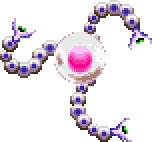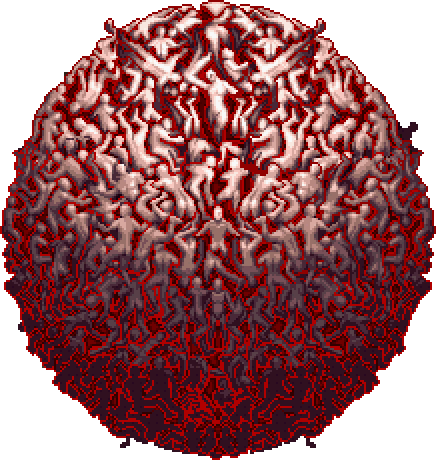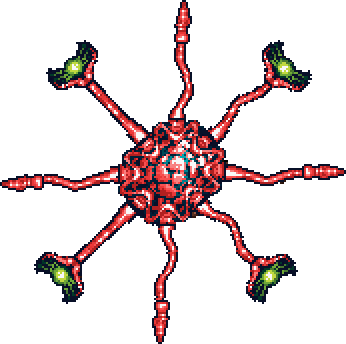
 Legion
Legion 
| . |
Castlevania:
Symphony of the Night
|
. |
This version
is called "Granfaloon" ("Legion" in the Japanese versions).
The large membrane surrounds itself in a sea of corpses that seek its light.
You'll be forced to break through the outer exterior and expose its center.
This won't be easy because it'll pause to drop drown multiple corpses and
command them to march toward you. As sections of the humanoids break off,
you'll expose its tentacles, and each will begin opening randomly to fire
beams; when all of the corpses have been destroyed, and the four sections
that they represent have been broken off, it gains the potential to do this
in eight directions. Attacking the membrane, while fighting off humanoids
and avoiding beams, is the only way to damage it.
| . |
Castlevania:
Harmony of Dissonance
|
. |
This Granfaloon-based enemy very much
mimics its big brother. The Legion is a three-tentacled eyeball that acts
as a core for a collection of tortured souls. The objective is to expose the
eyeball, by continuously striking the human formations which make up four
sections, and destroy it; eventually, the sections will begin breaking off.
To stop you from doing this, it'll command smaller legions to distract you.
Also, if a tentacle is exposed during this time, it'll begin waving around
and randomly firing a beam in a given direction. When the eyeball is exposed
completely, the challenge begins via its most powerful attack, as all of the
tentacles will begin firing beams in random directions; if you're unlucky,
one or two beams will be coming at you at a time.
| . |
Castlevania:
Harmony of Dissonance
|
. |
Harmony features a second type
of Legion: The Legion (Corpse). The second version, though, is a bit different
in its method. Since its exterior of skull heads is indestructible, your whip
attacks will appear to be ineffective. So in order to topple this ghastly-looking
foe, you'll have to do some work. Mainly, you must whip its middle section
repeatedly to force open a womb in which its core, a skeleton formation, rests.
When it eventually opens up, you'll have to continue to whip the center so
that it doesn't close up the wound. The Legion won't just allow you to do
this; it will hold you off by two means: Deadly globule that sprays out from
its sides and drips down from its frame, and poisonous larva that begins crawling
out of its middle once its forced open.
| . |
Castlevania:
Aria of Sorrow
|
. |
 |
|
|
 |
"He is many, and he is one,"
as Aria's enemy list tells us. Before entering into the Legion's chamber,
you'll see many human formations escaping from a chamber and marching toward
it, seeking its light. The Legion is most similar to his previous forms, but
the battle this time will be different--mainly, its chamber is a big room
with a large center platform that has platforms branching out of its sides;
the Legion will always be circling the platform, following you clockwise or
counterclockwise, so you'll be going around and around. Once again, you'll
have to break off its four human-shield sections to reveal its tentacle nucleus;
all the while, it'll be releasing single humanoids to clutter up the surrounding
platforms. As you break off sections, any exposed tentacles will begin firing
those annoying beams, with the ability to do this in three directions once
the nucleus is totally exposed. At this point, the Legion can move anywhere
it wants, with an extra ability: It can curl into a complete ball and rebound
around the chamber.
| . |
Castlevania:
Curse of Darkness
|
. |
 |
|
|
 |
This version of the Legion is Curse
of Darkness' "secret" boss; it's described as a lump of flesh
made from innumerable human sacrifices. Hidden deep below the Garibaldi Temple,
where even the walls pulsate with hatred, is a chamber where the Legion incubates
perhaps an ultimate evil (we meet only the unevolved Nuculais). The tall cylindrical
chamber has lining its sides a spiral staircase, which rotates around the
centered Legion. Hector must climb the staircase and attack the Legion from
all sides, piece by piece eliminating the shell of souls. The task is not
so simple: He will at all times be under siege by the many escaped souls,
which will continue to rise up from the ground. After struggling for a short
period, a soul will ultimately succumb and explode into a mess of melted flesh;
any contact made with a soul upon its explosion will lead to critical damage--even
your most durable Innocent Devil will fall easily to it. If you can avoid
the swarm of souls and totally eliminate the shell, you'll find a second secret
boss--the aforementioned Nuculais.
| . |
Castlevania:
Portrait of Ruin
|
. |
Portrait of Ruin isn't ashamed
to borrow from past titles in the area of enemy and boss creatures, and it
does so with sometimes perfect emulation. That's certainly the case here,
where you'll encounter the Legion, which is pound for pound the very same
enemy you knew as Granfalloon in Symphony of the Night. You know the
drill: You'll have to clear away its shell of tortured humanoids and attack
its nucleus; any tentacle exposed before total emasculation will protect the
Legion by randomly firing a beam. Despite its same-skin nature, it has in
this title one exclusive attack: When the nucleus is fully exposed, the tentacles
can execute a protective measure where four of eight fire sustained flame-blasts
while the Legion itself for a period rotates clockwise then counterclockwise.
| . |
Castlevania:
Grimoire of Souls
|
. |
 |
|
|
 |
Grimoire of Souls' version of
the legion is patterned after Symphony of the Night's, and thus it
functions very similarly. Like Symphony's, this legion (nicknamed "All
for One") is
a large membrane surrounds itself in a sea of corpses that seek its light,
and defeating it as a matter of attacking its shell--breaking it off piece
by piece--and then exposing and destroying the core of its membrane. As long
as least one section of the shell is intact, the legion will attack by shedding
multiple corpses, all of which proceed to lurch forward and attempt to grab
onto their attacker, and release globulous projectiles that fly in random
directions. Its exposed tentacles will intermittently spew flames over the
area they cover; at times, pairs of them will prolongedly fire deadly purple
lasers. The fully exposed membrane can execute three attacks: As it rotates
(surviving) tentacles will spew flames or fire purple lasers, and it'll otherwise
electrify itself and begin rebounding about the room.
Back

![]() Legion
Legion ![]()











